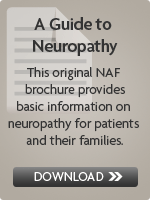

Overview
By Jeffrey W. Ralph, MD
“Neuropathy” means “disease of nerve.”
The term “peripheral” means that the disease is occurring to nerve tissue outside the brain and spinal cord. This includes injury of nerves to muscles (motor nerves), nerves from the skin (sensory nerves), and/or nerves to the gut and other internal organs (autonomic nerves).
Peripheral neuropathy is a very broad topic that demands classification for purposes of diagnosis, evaluation, and treatment. An initial distinction may be made between focal and generalized peripheral neuropathies.
A focal neuropathy means only one or, at most, a few nerves are injured. Pain, numbness, and weakness are confined to a single limb or a small region of the trunk or head. Focal neuropathies are typically caused by compression or trauma. Carpal tunnel syndrome, a common syndrome characterized by nighttime numbness and tingling in the hand, is an example of a focal neuropathy. Compression of a major forearm nerve called the median nerve causes this syndrome.
Generalized neuropathies present as pain, numbness, tingling, and, sometimes, weakness that affect both sides of the body. The feet and toes are commonly affected early in the course of a generalized neuropathy. As discussed in the “Causes of Peripheral Neuropathy” section, generalized neuropathies are often associated with general medical problems. Generalized neuropathies are also called polyneuropathies. I will use these terms interchangeably in Neuropathy 101.
A physician may also classify a neuropathy as being predominantly “axonal” or “demyelinating.” These are technical terms that refer to the microscopic component of the nerve that is being damaged. All nerves that supply muscles and the skin are comprised of microscopic fibers that carry the (electrical) information along the nerve. You may understand this by thinking of all the individual wires inside the main cable that goes to your computer printer. Within these fibers are cores called axons; these are analogous to the copper inside the wires. Most axons are ensheathed in fatty tissue called myelin. Myelin is required for the rapid transmission of signals along the axons. Myelin is analogous to the rubber insulation around wires. Whether a neuropathy is axonal or demyelinating has implications for medical work-up and treatment options. Nerve conduction studies (NCS) are required to distinguish between these two types of neuropathies. Axonal neuropathies are more common than demyelinationg neuropathies. In order to simplify the subsequent discussion of peripheral neuropathy, I will not distinguish axonal from demyelinating neuropathies; the discussion will apply to both types.

